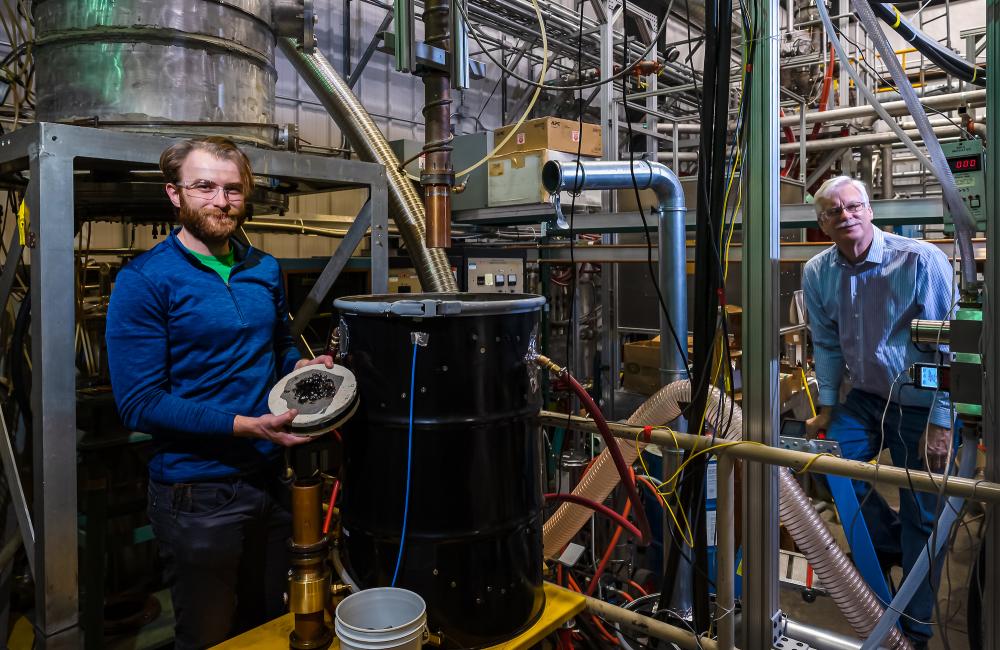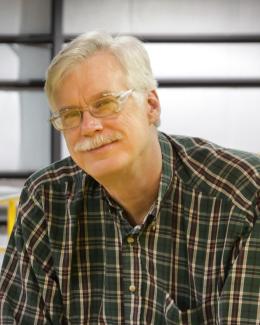ORNL fusion technology scientist Tim Bigelow, right, stands near the control console in ORNL’s fusion control room with Matt Houde of Quaise Energy. Their partnership aims to tackle technical challenges with the Millimeter Wave Drilling System that Quaise has developed. Credit: Carlos Jones/ORNL, U.S. Dept. of Energy.
Researchers in the geothermal energy industry are joining forces with fusion experts at the Department of Energy’s Oak Ridge National Laboratory to repurpose gyrotron technology, a tool used in fusion. Gyrotrons produce high-powered microwaves to heat up fusion plasmas.
“If we are successful, this technology will allow power plants across the United States in any geographic area to produce electricity using geothermal steam, a carbon-free clean energy resource,” said Tim Bigelow, a scientist in ORNL’s Fusion Technology group. “Currently, geothermal energy is not widely used because it isn’t cost-effective in most regions using conventional drilling methods.”
Gyrotron technology could change that.
“We sought ORNL as a partner to develop this technology because of its gyrotron equipment and expertise from fusion research, two things that our company needs to take the experiments to the next level,” said Matthew Houde, a co-founder of geothermal energy company Quaise Energy.
Geothermal energy originates in the Earth’s crust, the planet’s outermost shell, which ranges in thickness from 4 to 40, depending on location. Some heat in the crust is generated by the decay of radioactive materials, while some is left over from the planet’s formation 4.5 billion years ago.
To capture this energy, engineers drill wells and pump water down to extract steam resulting from the heat and then convert it into electric power. In the United States, the most accessible reservoirs of geothermal energy are in the West, where the heat is readily accessible at shallow depths. But in other areas, geothermal energy is only accessible at around 12 miles below the surface, where traditional drilling bits cannot reach.
To solve this problem, Quaise has focused on the gyrotron, a device that converts energy from an electron beam into a type of electromagnetic wave called a millimeter wave. This is a close cousin of the microwaves that power home microwave ovens.
Quaise is commercializing a gyrotron-enabled technique called the Millimeter Wave Drilling System — invented at the Massachusetts Institute of Technology’s Plasma Science and Fusion Center — to drill deeper and at higher subterranean temperatures, which can wear traditional drilling bits faster than in shallower depths.
The company’s end goal is to enable the conversion of existing fossil fuel power plants to run on carbon-free geothermal energy, thereby reducing emissions.
DOE’s Advanced Research Projects Agency-Energy is funding the project. By working with ORNL fusion experts, Quaise will tackle technical challenges — such as electrical arcing — that need to be resolved before the technology can be deployed.
The research will also help advance fusion research.
“In the end, there will be a feedback loop as we apply what we learn from developing this geothermal energy technology to our fusion energy research,” Bigelow said. “In essence, we are advancing the forefront of two avenues toward the same goal of carbon-free energy.”
UT-Battelle manages ORNL for the Department of Energy’s Office of Science, the single largest supporter of basic research in the physical sciences in the United States. The Office of Science is working to address some of the most pressing challenges of our time. For more information, please visit energy.gov/science. — Amy Reed and Andrea Schneibel



